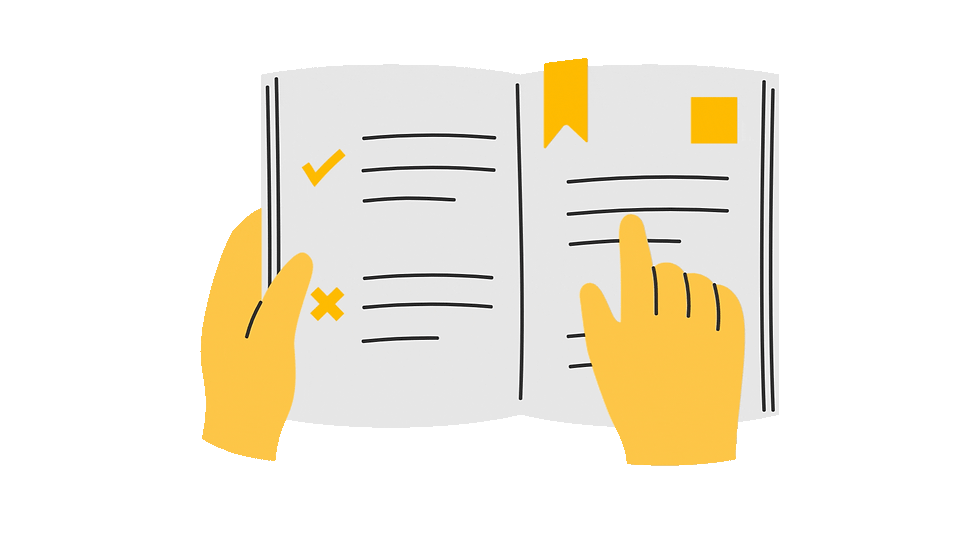How to Stop Getting Tricked by MCQs
- 5 days ago
- 7 min read
Stop Getting Tricked by “Most,” “Best,” and “Except”

If you’re anything like most candidates I’ve worked with, you don’t fail PEBC MCQs because you “don’t know enough.”
You fail them because of stuff like:
You miss a tiny word like “NOT” or “EXCEPT.”
You overthink two good-sounding options and pick the wrong one.
You rush through the stem and let the options drag your brain around.
You walk out of mock exams thinking,
“I knew that… I just didn’t answer it properly.”
The written exam isn’t just testing your knowledge.It’s testing your MCQ reading skills.
The good news: those skills are trainable.
30 Second Summary

This article is for you if you often miss tiny words in MCQs like “most,” “least,” “not,” or “except.”
You’ll learn a 5-step method to read MCQs: understand the stem, spot key words, guess first, cut bad options, then pick the safe, simple answer.
It includes non-therapeutic examples (ethics, DI) so you can see the steps in action.
If you walk out of tests thinking “I knew that, but I read it wrong,” this article helps you read questions like an examiner, not like a rushed student.
A Simple System for Reading MCQs Like an Examiner

In this post, I want to give you a step-by-step system to approach almost every PEBC MCQ in a consistent way.
By the end, you’ll know how to:
Decode the key words in the stem (negatives, superlatives, qualifiers, absolutes)
Use the options strategically instead of letting them confuse you
Handle questions where more than one option is technically true, but only one is the key
Make better guesses when you’re down to two options, without spiraling into overthinking
Think of this as your MCQ decoder: a small set of habits that catch the tricks exam writers use over and over again.
Why This Works (and Where It Came From)

Strong PEBC test-takers tend to do the same things:
They spot “landmine words” in the stem — negatives like not, none, neither, except; superlatives like most, best; qualifiers like usually, often, may; and absolutes like always, never, every.
They’re suspicious of answers that use extreme language (“always,” “never,” “all patients”) unless it’s a rock-solid fact.
They read the question first, think of a rough answer, then look at the options.
They use process of elimination first — removing obviously wrong or unsafe options — before choosing between what’s left.
They remember that more than one option can be true, but only one is the most appropriate for that specific stem.
They build speed by doing frequent, focused reps, so patterns become automatic.
On top of that, there’s a simple exam trick that saves a lot of marks:
When you’re stuck between two options that both sound reasonable, the correct answer is often the simple, safe, “boring” one that directly answers the problem.
Let’s wrap all of this into one framework.
The 5-Step PEBC MCQ Decoder

Here’s the system:
Box the stem
Highlight the landmines (key words)
Predict your answer first
Eliminate aggressively
Choose the “boring but best” option
Step 1 – Box the Stem Before you look at any options, your only job is to understand the question.
Ask yourself:
What are they actually asking?
Diagnosis?
Next best step in management?
Most likely cause of an issue?
Best counseling point?
Most appropriate auxiliary label?
What is the patient context?
Age, comorbidities, meds, time-course, community vs hospital, etc.
What is the task verb?
“Which of the following is MOST appropriate…?”
“Which of the following is LEAST likely…?”
“Which medication should NOT be included…?”
You cannot choose the right answer if you’re answering the wrong task.
So Step 1 = “What exactly is this question hiring me to do?”
Step 2 – Highlight the Landmines Next, you scan the question for key words that change the meaning.
Look for:
Negatives: none, not, neither, except
Superlatives: most, best
Qualifiers: usually, often, generally, may
Absolutes: always, never, every
These tiny words do a lot of damage if you ignore them.
Example patterns:
“Which of the following is NOT recommended…?”
“Which of the following is MOST appropriate…?”
“Which of the following is LEAST likely to cause…?”
“Which statement is always true about…?”
On paper, underline or circle them. On screen, mentally bold them.
If you flip “most” and “least,” or you miss “not,” you can know the content and still lose the mark.
Step 3 – Predict Your Answer Before Looking Down Once you understand the question, pause.
Before you look at the options, ask yourself:
“If I had to answer this with no choices, what would I say?”
Why this works:
You activate what you actually know (guidelines, mechanisms, priorities).
You anchor your thinking before the distractors try to pull you sideways.
If your predicted answer shows up in the options, it’s often (not always) a strong contender.
Even if you can’t name the exact drug, you can predict the type of answer:
“Something that doesn’t need refrigeration.”
“The med least suitable for a blister pack (e.g., PRN hypnotic vs daily chronic med).”
“The auxiliary label that matches a grapefruit interaction.”
You’re not trying to be a genius here — you’re just giving your brain a direction before it hits the options.
Step 4 – Eliminate Aggressively Now you finally look at the options—through the lens of the question.
Think:
"Who can I safely throw overboard first?"
Use process of elimination:
Cross out options that are:
Clearly unsafe
e.g., putting insulin pens in the freezer, giving a contra-indicated drug.
Clearly off-topic
Doesn’t answer what the stem actually asked for.
Directly contradicted by the stem
Wrong age, wrong route, wrong setting.
Overly absolute, when you know it isn’t always true
“All patients…”, “never,” “always,” “every.”
If you can eliminate even one option, your chances go up.Two or more? You’ve already made the question easier, before you even “know” the answer.
If you can eliminate even one option, your chances go up. Two or more? You’re now choosing between fewer traps.
Step 5 – Choose the “Boring but Best” Option This is where most people choke
You’ve done everything right, you’re down to two decent-sounding options… and then you overthink yourself into the wrong one.
Here’s the tie-breaker I use with students:
Between the last two options, ask:
Which option directly answers the stem with no extra drama?
Which option is safer and more conservative?
Which option follows guidelines / law / basic safety rules without trying to be heroic?
In MCQs, the correct answer is often:
The one that is specific to what they asked (not vague or over-broad)
The one that doesn’t introduce new risk
The one that sounds a bit… boring
Not clever. Not “this one weird trick.”Just correct, safe, and aligned with how pharmacists are expected to think.
Applied Examples (Written-Exam Style)
Let’s walk through a couple of MCQ-style scenarios.

Example 1 – Confidentiality (Ethics)
Question
A pharmacist dispenses antidepressant and antiretroviral medications to a regular patient. Later that day, the patient’s employer calls the pharmacy and says:
“We’re updating our benefits file and just need to confirm which medications they’re taking.”
Which action is MOST appropriate?
a. Confirm the list of medications since the employer provides the drug plan. b. Ask the employer to fax a request on company letterhead before disclosing the list. c. Politely decline to disclose any information and suggest they speak directly with the patient. d. Provide only the “non-sensitive” medications and withhold the antiretroviral.
Decoding Example 1 – Confidentiality (Ethics)
Box the stem
Scenario: third party (employer) calls about a patient’s meds.
Task: choose the MOST appropriate action.
Highlight landmines
“MOST appropriate” → several options may look “sort of okay,” but only one is fully aligned with confidentiality and consent.
Predict an answer
You already know:
Employers are not automatically entitled to PHI.
You need the patient’s consent to release medication info.
Safest answer: protect confidentiality, redirect to patient.
Eliminate
(a) Confirming meds directly to the employer = clear breach → gone.
(b) Company letterhead doesn’t replace patient consent → still a breach → gone.
(d) Disclosing “only some meds” is still unauthorized disclosure → gone.
Choose the boring best
(c) is simple, safe, and fully respects confidentiality → pick (c).
Notice: no tricks. Just the boring but correct ethics move.
Example 2 – Drug Interaction (DI Question)
Question
A 68-year-old patient stabilized on warfarin for atrial fibrillation presents with a new diagnosis of uncomplicated otitis media. The prescriber is considering starting one of the following oral antibiotics.
Which antibiotic is MOST appropriate if the goal is to minimize the risk of a significant increase in INR?
a. Trimethoprim–sulfamethoxazole (TMP/SMX) b. Metronidazole c. Ciprofloxacin d. Amoxicillin
Decoding Example 2 – Drug Interaction (DI Question)
Decoder in action
Box the stem
Task: choose the antibiotic that minimizes interaction risk with warfarin (INR increase).
Highlight landmines
“MOST appropriate” in the context of warfarin interaction. This is not just “what treats otitis,” but “what treats otitis with the least INR chaos.”
Predict
You may recall:
TMP/SMX and metronidazole are well-known to significantly increase INR.
Many fluoroquinolones (like ciprofloxacin) can also interact.
Plain amoxicillin tends to have less impact on INR than the others (still monitor, but lower risk).
Eliminate
(a) TMP/SMX → strong warfarin interaction → gone.
(b) Metronidazole → classic warfarin–INR interaction → gone.
(c) Ciprofloxacin → can interact with warfarin as well → not ideal.
Choose the boring best
(d) Amoxicillin effectively treats many otitis cases and is comparatively lower risk for INR spikes → pick (d).
Again, the correct answer is not flashy — it’s the safe, guideline-aligned, boring choice that respects the stem’s priority (minimizing INR impact).
5-Minute Daily Drill: Train the Decoder

To turn this from “nice idea” into muscle memory, use this quick routine:
Every day (5–10 minutes):
Take 3–5 MCQs (old exams, ones you write yourself or the Knowbly Lab).
For each question, force yourself to:
Box the stem
Write one line: “This question is asking for __________.”
Highlight key words
Spot not, except, most, least, usually, always, never, etc.
Predict your answer before looking at options
Eliminate at least 1–2 options out loud
“Unsafe because…”, “Off-topic because…”, “Too absolute because…”
If you’re stuck between 2, ask
“Which is the boring, guideline-aligned, safest choice?”
After checking the correct answer, jot down one reflection sentence:
“This was right/wrong because I missed / caught [keyword / safety principle / purpose of the stem].”
Do this for a week and you’ll start to:
See the same word patterns over and over
Calm down when you’re stuck between two options
Lose fewer marks to silly misreads and wording tricks
Putting It All Together
The MCQ Decoder doesn’t replace clinical studying.
But when you layer it on top of your therapeutics and non-therapeutic knowledge, you:
Stop leaking marks on pure wording
Start seeing PEBC questions as patterns, not random landmines
Use what you already know more efficiently on exam day
You’re not just “studying more” — you’re answering better.
And once you’ve trained this on general MCQs, you can start applying the same logic to:
Ethics & law questions
Storage & stability pearls
Labeling & auxiliary label questions
DI and documentation MCQs
That’s where your score starts to climb without needing to add five extra hours of studying a day.



Comments